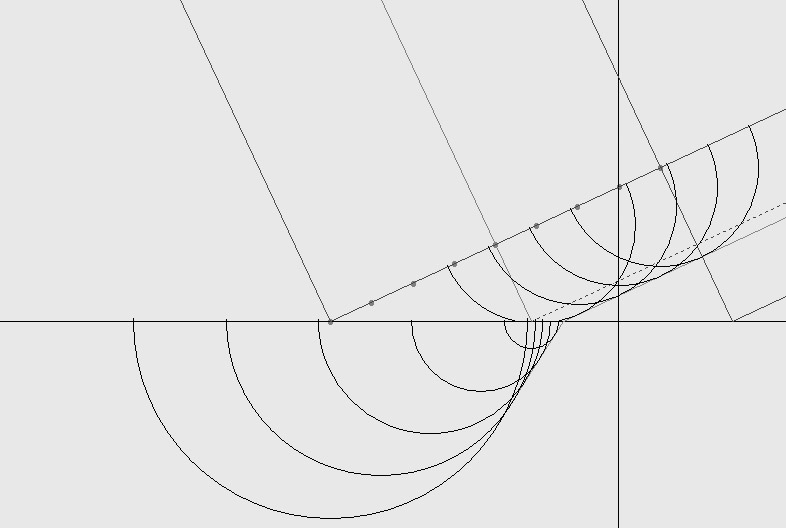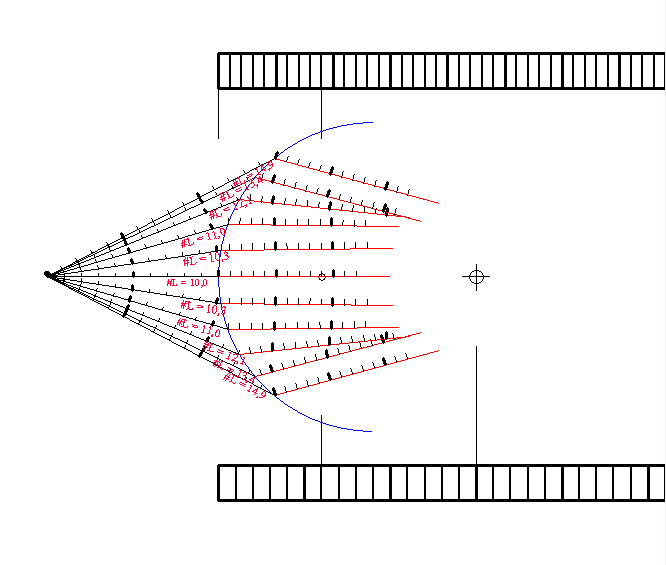physics programs by PAVLOS MIHAS,
Department of Primary-Level Education, DEMOCRITUS University of
Thrace (DUTH)
The following programs were created in a Visual Basic Environment (if you do not want to download the exe files mailto:pmichas@eled.duth.gr to ask for zip files)
There are programs on: coils,
rotating
frames, waves, OPTICS (Huygens'
principle, Huygens
construction of lens for perfect focusing, Fermat's
principle plus Huygens, curved mirrors,
concave
mirrors, eclipses,
Refraction, lenses, Rainbow, Penumbra
Determination of focal
lengths), CHEMISTRY,
Al Haytham's
Problem (AlHazen's Problem) and Huygens' solution to it
Try to download the .EXE files. Back to the TOP
a)Induction on Coils
Click on INDUCTION for the induction program. (Published in Physics Education, January 2003)
b) Mechanics and Rotating frames:
Program neil_curve.exe
that examines the curve proposed by William Neile. For a special value of the
velocity (called alfa) the vertical component remains constant.
The student can see that the radius o curvature decreases and becomes zero at
the top. The centripetal acceleration becomes infinite.
Program sinusoidal: examines the factors that affect centripetal acceleration
Program
kykloeides.exe and cycloid.exe
(newer edition of kykloeides) shows 1) The size of the radius of curvature of
the cycloid pendulum compared to the cyclical pendulum
2) The 2 pendulums as they vibrate. T he
cyclical follows the exact solution (w
he
cyclical follows the exact solution (w ith
elliptic functions)
ith
elliptic functions)
Program KENTRO_bMAGNET.exe
show the evolution of the path of a charged body in a magnetic field. It can
also be used in conjunction
with the program rotating_English to show the Foucault pendulum
Click on rotating_frame
for a program of rotating frames which examines friction and pseudo - forces.
Other topics: Foucault's pendulum, kinematics on 2 dimensions.
Back to the TOP
c) Waves: A
program SEISMIC_P.exe
shows the propagation of waves in a medium where the speed changes with the depth.
for longitudinal waves depicting the rays and Waves fronts. It is useful in connection with teaching the change of speed (in sound waves, as in change of velocity due to gradual temperature change) and in seismic waves. Another program longitudinal.exe (108 kB) examines the propagation of a pulse. It is possible to have two different media. The end can be fixed or free. This helps to explain why a rarefaction pulse (depression in Seismology) causes the ground to move downwards when the first pulse arrives, while a compession pulse causes the ground to move upwards
The program:curved_radii.exe gives an animated display of wave fronts with two different dependencies of the speed of the wave with depth.
.Back to the TOP
The software KYMATA.EXE helps the study of the transmission (from right to left) of TRANSVERSE wave pulses and the study of reflection at fixed or free end.
For the wave pulses the EXCEL file pulses REFLECTION AND REFRACTION.XLS gives the forms of wave pulses as they travel from one medium to another
For the wave fronts the EXCEL file GRADUAL
CHANGE.xls gives the form of rays when the wave speed is not constant
d) Optics programs
1.
The first program deals with Al Haytham's theory
of the appearance of the meniscus of Sun's eclipse on the
screen of a pinhole camera. You can find some information on this in the
article by Pavlos Mihas(2001): A historical example of the use of
the 'pinhole camera', pp 19 - 21, SCHOOL SCIENCE REVIEW -July
2001
"EKLIPSI".
Back to the TOP
The second pr gram deals with Al Haytham's theory on the nature of the Moon's surface .
The question was: Does the moon reflects like a mirror or it reflects diffusively?
This program expands on Al Haytham's ideasMOONREFLECTION the zip file is MOONZIP
You can find explanations on the model in the article by Pavlos Mihas (2002): Some historical resources for teaching about curved mirrors, PP 311-317, PHYSICS EDUCATION, July 2002 (available from the site of Physics Education http://www.iop.org/EJ/S/0/20190/journal/0031-9120
- The third program deals with Al Haytham's treatment of concave mirrors.
It presents two contributions by Al Haytham:
a) The composite spherical mirror. In this program you will examine how Al Haytham dealt with the fact that actually there is not a point focus for spherical mirrors - as opposed to parabolic.
b) Al Haytham's question of how many points on a mirror can join through reflection two given points
The program is:
You can find explanations on the model in the article of PHYSICS EDUCATION,
July 2002 mentioned in # 2.
Back to the TOP
4. A program examining the history of the law of REFRACTION. In this program there is an option for the
examination of ERRORS, another option for HISTORICAL MEASUREMENTS. In the
HISTORICAL notes are included the PTOLEMY'S method for determining the angles
of REFRACTION which is essentially the method of pins, Al HAYTHAM'S method of
determining the angles of refraction which is the method of light bundles. DIATHLASI.exe
You can find explanations in the article by Pavlos Mihas (2001): Educational Software Connecting History of Optics with the Optics Laboratory, THEMES IN EDUCATION Volume 2 - Number 1, 2001 pp 59 - 70 (Publisher LEADER Books, journals@leaderbooks.com) You can find information on the Themes In Education on the site of the University of Ioannina: http://www.uoi.gr/schools/edu/ptde/themes or on the site of Leader books: http://utopia.duth.gr/~pmichas/aglika/www.leaderbooks.com. Also presented in Leeds at the 8th History and Philosophy of Physical Sciences in Science Teaching (July 2005)
5. A program which examines the properties of spherical lenses and IBN SAHL'S (9th century) HYPERBOLIC LENS FAKOI.
Another version
of this program shows the thin lens model and the thick lens model
The article by Pavlos Mihas (2003): Using History in Teaching Optics, pp
15 - 23 in THEMES OF EDUCATION volume 4 - Number 1 refers to the use of History
in teaching Optics. Also presented in Leeds at the 8th History and Philosophy
of Physical Sciences in Science Teaching (July 2005)
Back to the TOP
6. A program which examines the ideas of AL FARISI who in the 14th
century presented the first mathematical theory for the shape of the rainbow 2 centuries before DESCARTES. This program shows the
refraction and reflection in the interior of a sphere toxo
7. A program that examines and expands the ideas of AL HAYTHAM on the intensity of light in a PENUMBRA
9.
Determination of focal lengths:
An Excel file contained in the file focal . This Excel file contains macros which
should be activated .
These macros permit the user to find all the cuts of the lines x/a+y/b=1 (which
are drawn between the points (a,0) and (0,b))where a is the distance ofthe
objec
10.
 HUYGENS'
PRINCIPLE Shows the wavelets that combine to give a wave front
HUYGENS'
PRINCIPLE Shows the wavelets that combine to give a wave front
 11.Huygens
construction of
lens for perfect focusing Uses the method presented in "La TRAITEE
11.Huygens
construction of
lens for perfect focusing Uses the method presented in "La TRAITEE  DU LUMIERE It is in two forms: Huygens Lens which shows the shape
of a lens with rays and wave fronts and Huygens Lens Construction which permits to
the students to draw a lens (with a circle or an hyperbola on the left side)
DU LUMIERE It is in two forms: Huygens Lens which shows the shape
of a lens with rays and wave fronts and Huygens Lens Construction which permits to
the students to draw a lens (with a circle or an hyperbola on the left side)
 12. Fermat's
principle: Shows how Fermat's principle can be applied in
conjunction with Huygens' principle to find the point where the rays or
wavefronts converge. It is included in the software lenses
(www.kyriakosxolio.gr/lenses.html)
12. Fermat's
principle: Shows how Fermat's principle can be applied in
conjunction with Huygens' principle to find the point where the rays or
wavefronts converge. It is included in the software lenses
(www.kyriakosxolio.gr/lenses.html)
A similar program shows also the thin lens model with a cross and the thick lens approximation.
